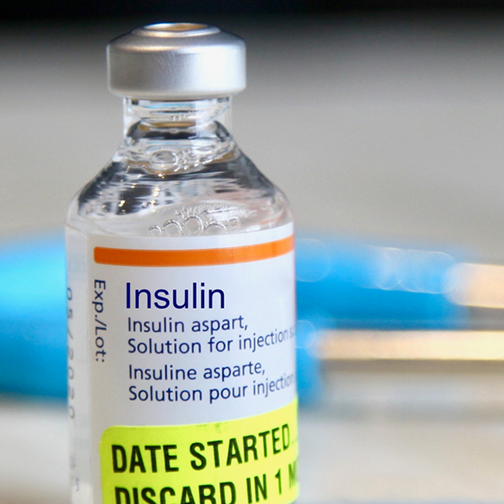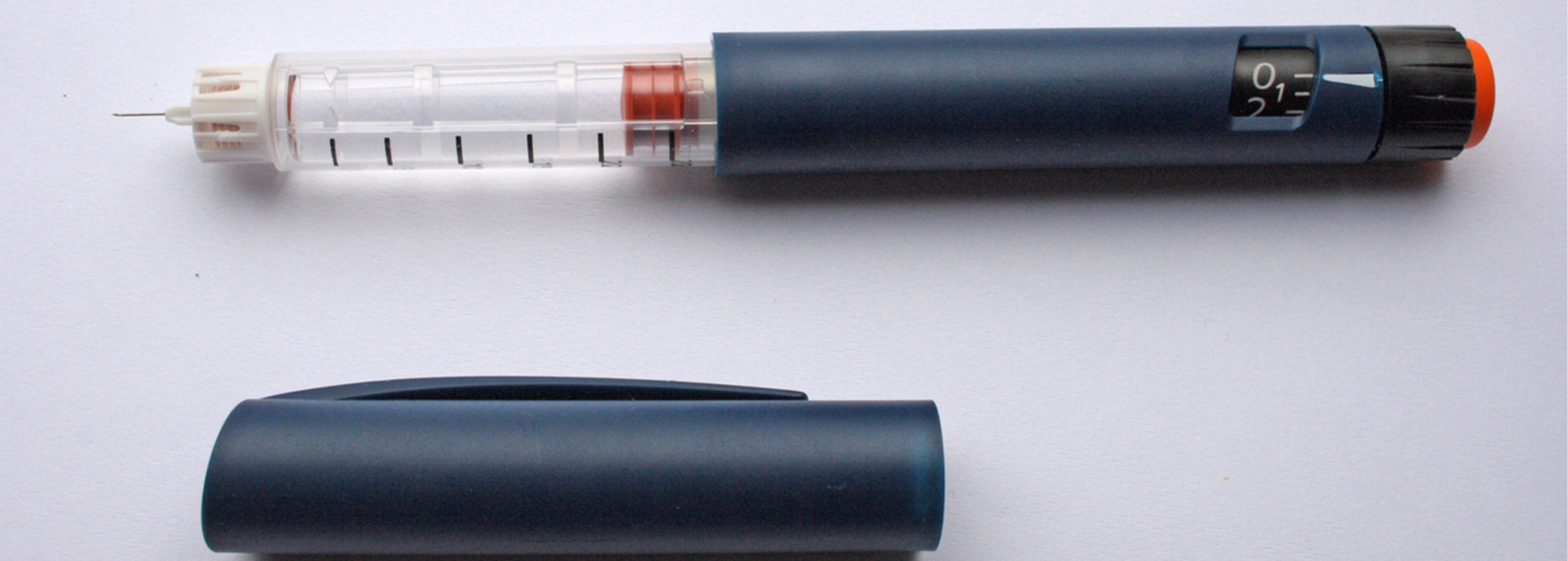Insulin Pumps for Type 2 Diabetes
Insulin pumps can be incredibly helpful for people with diabetes. While many people still prefer the traditional method of taking multiple daily injections (MDI), insulin pumps can truly change life with diabetes.
- Traditional insulin pumps: Today’s insulin pumps are small, computerized machines that deliver insulin through a tiny catheter inserted into the skin with a small needle or cannula. They can be programmed with very specific, detailed hours and dosages to cover both your basal (background) and bolus (mealtime) insulin needs.
- Disposable patch pumps: Disposable insulin “patch” pumps offer a very simple method of delivering insulin without injections. Determining which type of patch pump is right for you may depend on whether you need both basal (background) and bolus (mealtime) insulin or just bolus insulin. Options include a three-day wearable patch and a one-day wearable patch. Disposable insulin patches offer easy insulin dosing with a simpler system.
Understanding “basal” and “bolus” insulin
Pumps are designed to operate similarly to the human pancreas, but it is still important to check your blood sugar while using a pump. Some pumps communicate directly with continuous glucose monitors (CGMs) or you can use a traditional blood glucose monitor with test-strips and finger pricks.
- Basal: The “basal rate” in your pump is programmed to be given through a gradual drip each hour. These relatively small, continuous doses of insulin manage your body’s “background” insulin needs. The human body needs insulin 24 hours a day in order to use the glucose (sugar) in your bloodstream for fuel.
- Bolus: A “bolus” is a larger dose of insulin given for meals and to correct high blood sugars. Every time you eat or drink any calories, your body turns some of that meal into glucose (sugar) that enters your bloodstream. The bolus of insulin helps your body use that glucose for fuel and store extra glucose in your muscles (glycogen) or as body fat.
It is important to understand the differences between MDI and pumps in order to optimize your personal treatment plan for diabetes.
Using an insulin pump for Type 2 diabetes
Many people with type 2 diabetes can simplify diabetes management by using an insulin pump instead of taking injections. People with type 2 diabetes may need daily insulin for either (or both) of the following reasons:
- Insulin resistance: This is when your body isn’t responding to normal amounts of insulin and isn’t able to use that insulin effectively to manage your blood sugar levels. Some insulin resistance can be improved through lifestyle changes (like physical activity and weight-loss). For some people, insulin resistance is a deeper issue that cannot always be easily changed. This means you may need support from diabetes medications or insulin to help you manage healthy blood sugar levels.
- Beta-cell dysfunction: This is when your body struggles to produce normal amounts of insulin. Beta-cells are produced by the pancreas, then those cells produce insulin. In many people with type 2 diabetes, your body struggles to produce normally functioning beta-cells which means you don’t produce enough insulin. This can worsen over time, and your body is able to produce less and less insulin over time. This means you’ll need more support from diabetes medications or insulin to help you manage healthy blood sugar levels.
People with Type 2 diabetes who require insulin have several options today:
- Taking multiple daily injections with syringes or a pen, with rapid-acting (bolus) and long-acting (basal)
- Using rapid-acting inhaled insulin (bolus)
- Using an insulin pump with rapid-acting insulin (bolus and basal)
- Using an insulin patch pump with rapid-acting insulin (bolus/basal or just bolus)
In fact, thousands of people are using tubed insulin pumps and Omnipod—the only tubeless insulin pump—to manage diabetes. Today, there are now “patch” pumps, too, that offer a simplified version of pump technology.
Evidence shows that many people with type 2 diabetes could benefit using available technology, but most especially, insulin pumps. People with type 2 who take multiple doses of insulin daily should consider pump therapy.
Learning how to use an insulin pump and fine-tune your insulin doses is a process that requires some patience. You’ll work closely with your healthcare team to determine how much insulin your body needs to help you achieve your blood sugar goals!
Advantages of using a pump with Type 2 diabetes
- Pumps more closely function like an actual pancreas. With the basal and bolus insulin delivery, insulin controls effects of carbohydrates on blood sugar, pumps work similarly to the way a pancreas would and can give you less to think about.
- Achieving a lower A1C overall is not uncommon for people who opt to use insulin pump therapy, especially in comparison to multiple daily injections.
- Pumps help decrease the risk of hypoglycemia, as they alert the user when they’re low.
- Weight gain has not been a factor in studies of users testing pump therapy.
- Discretion: it can be easier to control and conceal pumps, as opposed to opting to give yourself insulin injections in public
- It makes carb counting easier by automatically calculating how much insulin you need based on how many carbs are in your meal.
Disadvantages of using a pump with Type 2 diabetes
- Cost is definitely a factor here. This is the main obstacle in most countries. For others, insurance companies have specific procedures for type 2 diabetes treatments. Health insurance plans vary and options like Medicaid and Medicare can be helpful in covering costs. Choosing the right health insurance plan is important, especially because not all health plans cover supplies like test strips, meters and pumps and those without any plan at all will pay entirely out of pocket.
- You’ll need training and support from your healthcare team. Insulin pumps aren’t difficult to use, but it may take awhile to get used to changing your pump sites every few days. You’ll also need to calculate your insulin to carb ratios and insulin sensitivity factor before using the device.
- Like all machines, pumps can malfunction or fail. Some people find it hard to trust machines with their life and opting for pump therapy does not mean you can stop monitoring your levels yourself. This can increase the risks of diabetic ketoacidosis (DKA).
People with type 2 diabetes often prefer insulin pumps because of the flexibility that the treatment provides and the freedom from injections. We can’t forget that every person with diabetes has specific requirements and that is why it’s important to choose, along with healthcare professionals, the best possible treatment plan for each individual.
Using insulin to manage Type 2 diabetes
For many people with type 2 diabetes, using insulin via injections or pump is an important part of managing healthy blood sugar levels.


Insulin Delivery Methods
Today, there are a variety of insulin delivery methods to choose from as a person with Type 2 diabetes. Learn about your options here!MORE

MDI vs Insulin Pumps in Type 2 Diabetes
People with type 2 diabetes have a choice in the treatment of their condition, and understanding any and all options is a vital first step in proper diabetes management.MORE

How Insulin Works
Insulin is a hormone that helps regulate your glucose levels. But it has other functions to help maintain your health. Read how insulin works. MORE

The Type 2 Diabetes Guide to Bolus Insulin
Bolus insulin can help prevent glucose spikes after meals or correct for high blood sugar. Learn more in our guide to manage T2D.MORE

Guide: Talking to Your Doctor About Insulin for Type 2 Diabetes
Starting insulin therapy for type 2 diabetes can be overwhelming—there’s a lot to learn! Here are some questions to ask your doctor to help you get started with using insulin.MORE

All About the CeQur Simplicity Insulin Patch
This ultra-thin wearable insulin patch is a simple and convenient way to deliver your mealtime and correction dose insulin!MORE

Guide: Asking Your Doctor About Using an Insulin Patch
The CeQur Simplicity insulin patch is so new that your doctor may not even know about it! Learn how to get the conversation started…MORE

Research: Practical Use of Closed-Loop Insulin Pumps
Closed-loop insulin pump technology is a game-changer for those taking insulin. Here are essential tips to using them in day-to-day life.MORE
Switching to an insulin pump
The process of switching to an insulin pump can feel a little overwhelming. If you’ve been taking non-insulin diabetes medications or taking injections, here are a few resources to help you with the transition.


Making the Switch: From Oral Medications to Insulin
People with type 2 diabetes have a choice in the treatment of their condition, and truly understanding available treatment options is extremely pertinent.MORE

Making the Switch from Pens to a Pump: What to Know
Switching from multiple daily injections (MDI) with an insulin pen to an insulin pump is a very exciting decision! Here's what you need to know...MORE

Insulin Pens vs. Insulin Pumps for Type 2 Diabetes
Using insulin to manage type 2 diabetes comes with options! Here are the pros and cons of insulin pens vs. pumps.MOREGetting an insulin pump
Learn about the process of getting an insulin pump and resources to help you manage the costs.


Suddenly Jobless or Without Health Insurance? Start Here.
If you've just lost your health insurance coverage or are struggling to afford your medications and supplies, start here.MORE

Don’t Have Health Insurance Right Now? Read This
You may qualify for subsidies that lower the cost of your insurance; here's what you need to know to pick a Healthcare.gov plan for 2022.MORE

Pump Access and Type 2 Diabetes
A person with Type 2 diabetes may eventually require insulin to manage glucose levels. Wearing an insulin pump can make that transition easier and simplify living with diabetes. Learn about pump acces...MORE

Expert Shares Tips on How to Get an Insulin Pump for Type 2 Diabetes
Joy Cornthwaite, MS, RD, LD, CDCES, joins Beyond Type 2 to discuss how people with Type 2 diabetes can get an insulin pump. MORE

Have Diabetes and Enrolling in Medicare? Start Here
Medicare can be hard to navigate and even more complex when you have diabetes. This step-by-step guide makes the process a little easier.MOREReal life with an insulin pump
Read real stories from real people with type 2 diabetes who use an insulin pump to manage their blood sugar levels.


Omnipod Helped Me Reduce My A1C by Nearly 10 Percent
After experiencing diabetic comas, neuropathy, and an A1C of over 17 percent, Prince was able to turn things around with the Omnipod insulin management system to reduce his A1C by nearly 10 percent.MORE

How Omnipod Simplifies Life with Type 2 Diabetes: A Chat with Insulet CCO Bret Christensen
Bret Christensen is the Chief Commercial Officer at Insulet, maker of the Omnipod Insulin Management System. He recently spoke with Beyond Type 2 to discuss his role at the company, how Insulet is ove...MORE

Feeling Like a New Person with the Omnipod System
John Hale is a Former Drill Sergeant who was diagnosed with Type 2 diabetes in 1999. After being diagnosed with prostate cancer, he had trouble bring his glucose down due to his medication. As a resul...MORE

Life is Easier with Omnipod
T2D patient Kathleen Weaver tells her story about wearing insulin pumps for 20 years and why life is easier with Omnipod DASH. MORE

With an Insulin Pump, Type 2 Diabetes Requires Less Effort
Russ Bell shares his T2D diabetes story, being encouraged to try Omnipod by his T1D granddaughter, and why T2D requires less effort to manage because of Omnipod. MORE

Being My Own T2D Success Story with Omnipod
Prince Blue joins Beyond Type 2 to discuss updates to his journey with type 2 diabetes, including finding weight loss success with Omnipod. MORE






